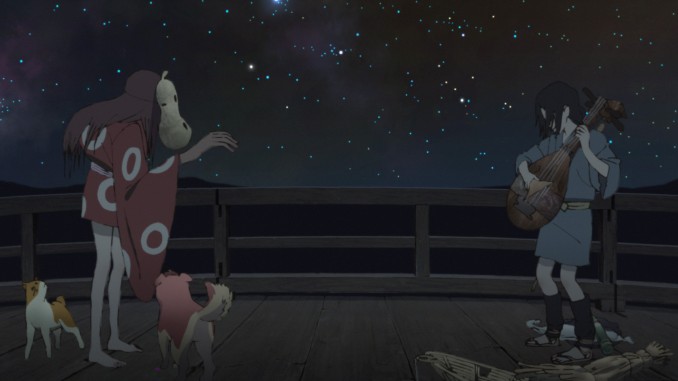Triumphant Anime Musical Inu-Oh Sees Rock Span the Ages

As the earth rocks beneath the dancing of the great Inu-Oh, there’s no doubt an epic tale is unfolding. Director Masaaki Yuasa’s musical drama Inu-Oh combines classical biwa instrumental sounds with energetic crowds you’re more likely to see at a rock concert than 14th-century Japan. Adapted from Hideo Furukawa’s novel The Tale of the Heike: The Inu-Oh Chapters, Inu-Oh is a true evolution of an ancient artform while also emphasizing friendship, legacy and who has the right to tell the stories of the departed.
Inu-Oh is the story of two boys, united by disabilities that change their fates forever. Tomona (Mirai Moriyama) and his father are given a mission from the shogunate to locate a missing Heike clan relic. The mission ends with tragedy as the young child is blinded. Tomona’s blindness defines his life for some time, but his journey leads him to a clan of monks. These monks play the biwa (a short-necked wooden lute) and recount the stories of the fallen Heike clan. Tomona finds his purpose, becoming a monk and reading old scriptural texts to those who would come and listen. Inu-Oh (Avu-Chan), is born with an elongated arm and a disfigured face that he hides behind a mask at all times. A pariah among the people of the village—he fights with the village dogs for his food—he dreams of learning the traditional dance known as Noh, and becoming a star on the stage. Noh utilizes masks, costumes and props to tell these historical tales, the perfect confluence of materials that would help Inu-oh blend into society and excel.
When the pair finally meet, Tomona’s blindness allows him to see past the physical complications that have haunted Inu-Oh’s life. A partnership is formed between a blind monk and deformed dancer—one that will revolutionize the music of the era, drawing large crowds with magnificent stage productions rivaling those of the 21st century. The only problem is that these classic instruments and dances are held to rigid principles, and should not be adopted into new stories and sounds. Even if the goal is to tell the tragic story of Inu-Oh’s life, that is strictly prohibited. That brings Tomona and Inu-Oh’s great new collaboration into direct conflict with the shogunate.
Those familiar with the work of Science SARU and Yuasa will undoubtedly know about the fluid movements of their characters. They move without the restrictions forced upon us by our bones and muscles, often swaying through the air in any old fashion. This translates well to the dance movements of Inu-Oh as he himself has a mystical body. His elongated limbs contort and move in a supernatural fashion, and it’s easy to see why his dance would have so many fans. Even Tomona benefits from this fluid motion, as he weaves through the crowds with his biwa and bellows out these new tales for the adoring masses below. The animated “camera” captures the performance in ways that would be impossible otherwise: Rather than simply watching the dance as a spectator, we’re given truly incredible vantage points.